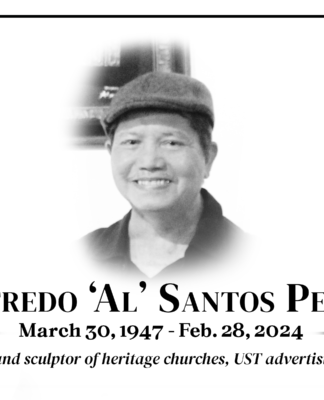EXCITED when the smoke issuing from the Sistine Chapel chimney was at last white, the ecstatic crowd in St. Peter’s square drowned even the pealing bells with loud chants Habemus papam!
The man in the white papal vestments stood before tens of thousands of pilgrims who had flocked to the square, raised his hands, and with a smile, addressed the crowd, calling himself “a simple and humble laborer in the vineyard of the Lord.”
Thus went Benedict XVI’s first audience with the Catholics in attendance, and indeed the rest of the world that waited with bated breath for Peter’s next successor.
For Rev. Fr. Ramon T. Salibay O.P. of the Center for Campus Ministry, Pope Benedict XVI is a genius, the perfect choice to succeed the late John Paul II.
“He is the most qualified among the papal candidates because of his work experience as the Prefect for the Congregation of the Doctrine of Faith. I am not surprised when he was elected,” Fr. Salibay told the Varsitarian.
The young Joseph
Born Joseph Aloysius Ratzinger on April 16, 1927, the new pope’s parents were a Catholic couple, Joseph and Maria, of Marktl am Inn in the southern German province of Bavaria. He had two elder siblings: Georg, now a priest-musician, and his sister Maria, who died in 1991. Ratzinger was six years old when Adolf Hitler ruled Germany, forcing many, including the Ratzinger family to go into hiding to escape Nazi dictatorship.
“Our father was a bitter enemy of Nazism because he believed it was in conflict with our faith,” Georg Ratzinger told the New York Times.
Against the Nazi’s anti-Christian sentiments, Joseph entered the minor seminary of Traunstein at the age of 12. Two years later, he left the seminary to join the Hitler Youth movement, as mandated at that time.
“In three days of marching, we hiked down the empty highway, in a column that gradually became endless,” Ratzinger wrote in his memoirs, published as Milestones: Memoirs 1927-1977 in 1998.
When he was 17, Ratzinger was sent near the Austro-Hungarian border to set up tank traps along with forced Jewish laborers. There, he saw Hungarian Jews being herded to death camps.
When the war ended in April 1944, with the Americans near their camps, Ratzinger deserted his troop but was recognized as a German soldier. He was then confined to a nearby camp at Ulm for a month and a half.
“The American soldiers photographed us, the young ones, most of all, in order to take home souvenirs of the defeated army and its desolate personnel,” Ratzinger told the Associated Press.
After being released in June, Ratzinger re-entered the seminary with his brother Georg. They were ordained as priests in 1951. And in 1959, he became a professor of theology at the Bonn University.
“He fascinated all of us with his wonderful angelic voice, his clear language, his deep intellect and powerful faith,” Prof. Max Seckler of Bonn University told Newsweek.
God’s Rottweiller
Wolfgang Beinert, an assistant and friend of Ratzinger when the future Pope transferred to the University of Tübingen, notes his “change of heart” from “liberalism” to “conservativism”. Ratzinger formerly advocated the loosening of ecclesiastical authority. The movement caused anti-clerical sentiments.
“The (Tübingen strikes) triggered a huge fright. Ratzinger believed that he was in some way responsible, guilty of the chaos, and that the university, the society and the Church were collapsing,” Beinert said.
From then on, Ratzinger wanted things back in order, a genuine liberation through a “Christian humanistic” order. Only last year, he debated with atheistic postmodernist philosopher Jurgen Habermas. They agreed that Christian tradition is vital to European identity and values.
Ratzinger’s last “reformist” tendencies were unleashed at the Second Vatican Council where he was an expert adviser. The sought-after lecturer was named archbishop of Munich and Freising in March 1977.
In early 1982, Pope John Paul II named Ratzinger the prefect of the Congregation for the Doctrine of the Faith, formerly known as the Holy Office of the Inquisition. To promote and safeguard the Catholic world’s doctrine on faith and morals, he clarified the Catholic Church’s position on other religions in the document Dominus Iesus, which talked about the proper ways to engage in ecu-menical dia-logues.
Af-ter five years, he became the cardinal-bishop of Velletri-Segni in 1993. After being the vice-dean in 1998, he eventually became the dean of the College of Cardinals in 2002.
Ratzinger exhorted the conclave of Cardinals just hours before the 115 Cardinals voted for Pope John Paul II’s successor.
“We are moving,” Ratzinger said, “toward a dictatorship of relativism that recognizes nothing definite and leaves only one’s own ego and one’s own desires as the final measure.”
The modern world, Ratzinger insisted, “has chaotically jumped from one extreme to the other: from Marxism to liberalism, up to libertinism; from collectivism to radical individualism; from atheism to a vague religious mysticism; from agnosticism to syncretism and on and on.” The Church for him must not fall for “fashionable ideas” but always stand firm on its teachings.
“Santo Papa”
When Vice President Noli de Castro led the Philippine delegation to the inauguration of the new Pontiff last April 24, Pope Benedict XVI expressed his gratitude to the Philippines, being the only predominantly Roman Catholic nation in Asia.
“I am happy that the Philippines remains the bastion of Catholicism in Asia and I am glad that Filipinos remain strong and firm in their faith in the Roman Catholic Church,” the Pope told the Vice President.
Joining the rest of the world in welcoming the new papacy, the Archdiocese of Manila hosted a concelebrated mass last April 26 at the Manila Cathedral as thanksgiving for the inauguration of Pope Benedict XVI as the 265th Supreme Pontiff of the Universal Church. His Holiness promised to visit the country anytime soon.
Like John Paul II, who is said to have loved the Philippines next only to his home-country Poland, Pope Benedict XVI can be just as loving. The Pope, like many Filipinos, faced hard trials of life at an early age yet managed to carry his cross with a strong faith and mind. Indeed, the “conservative” Pontiff must have had his own way of being “radical” for the faith. He knows how to expose unsound doctrines and invalid philosophies, but those who know him enough say he has a big heart and very willing to listen. Kris P. Bayos and Llanesca T. Panti














